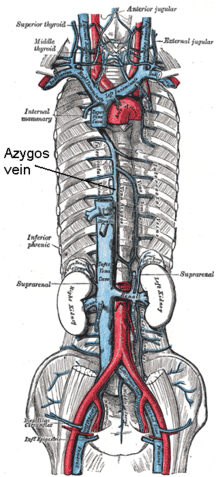Azygos vein
The azygos vein (from ancient Greek ἄζυγος , unbound) is a venous blood vessel in mammals that is located on the inside of the trunk to the right of the spine . Its counterpart on the left is the hemiazygos vein , which in humans flows into the azygos vein at the level of the 7th or 8th thoracic vertebrae .
After passing through a crack in the right lumbar thigh of the diaphragm , the vein arises from the right lumbar vein ( vena lumbalis ascendens dextra , which is connected via collaterals to both the vena cava inferior and the vena iliaca commonis ) and opens Level of the third rib into the superior vena cava ( superior vena cava ). Since it has cross connections to the inferior vena cava, it represents a possible collateral circulation between the upper and lower vena cava in liver diseases such as liver cirrhosis ( cavacaval anastomosis , portal hypertension), as well as in the presence of thrombosis of the vena cava or its constitutional absence ( azygos continuity ). From the chest cavity receives venous blood from the: venae intercostal (between ribs veins), venae oesophageae ( esophagus ), venae phrenic the superior (upper part of the diaphragm), venae bronchial ( bronchi ), venae pericardial ( pericardium ), venae mediastinales ( mediastinum ) and the intervertebral vein ( spinal cord area ).
An azygous lobe can develop through the azygous vein during the organogenesis of the lungs .
Azygos vein in animals
The azygos vena in horses and predators is comparable to humans . Here it is called the dextra azygos vein due to its course to the right of the aorta . It collects the blood from the intercostal veins and flows into the anterior vena cava ( vena cava cranialis ).
In the pair of ungulates , the corresponding vessel runs on the left side as the left azygos vein . This opens into the coronary sinus .
literature
- U. Gille: Cardiovascular and immune system, Angiologia. In: F.-V. Salomon et al. (Ed.): Anatomy for veterinary medicine. Enke-Verlag, Stuttgart 2004, ISBN 3-8304-1007-7 , pp. 404-463.
